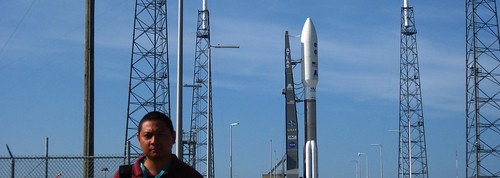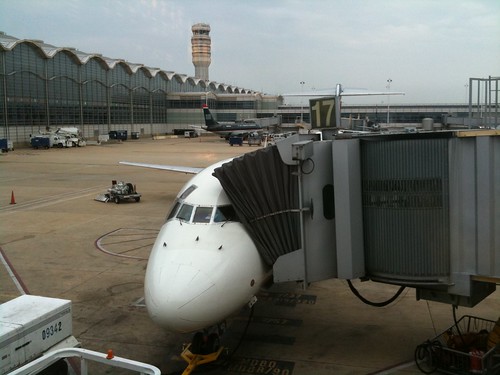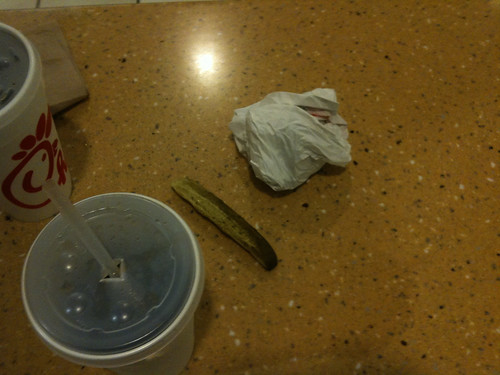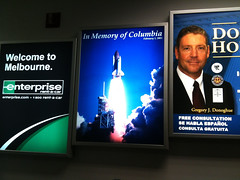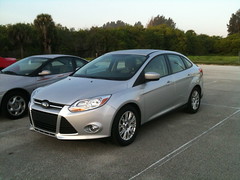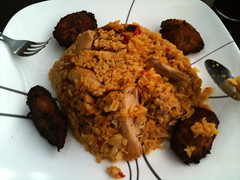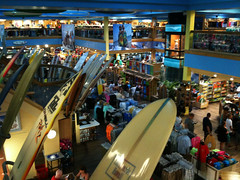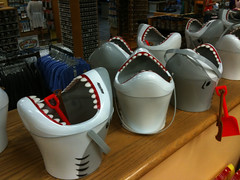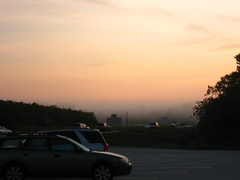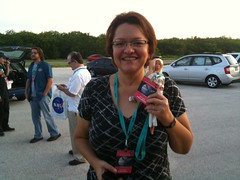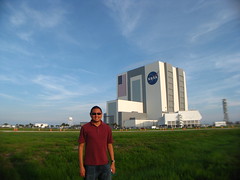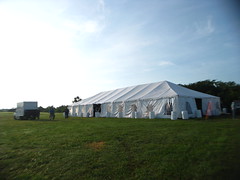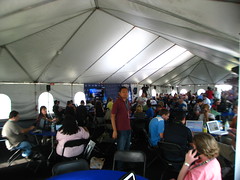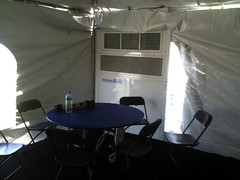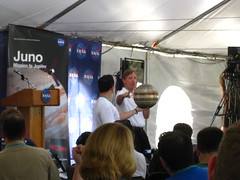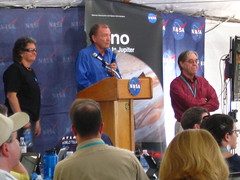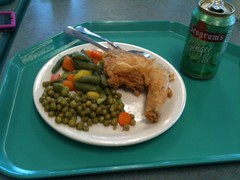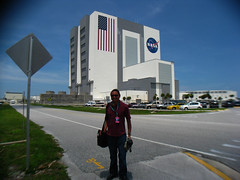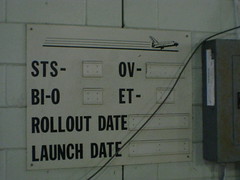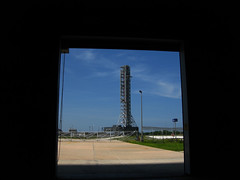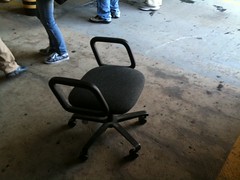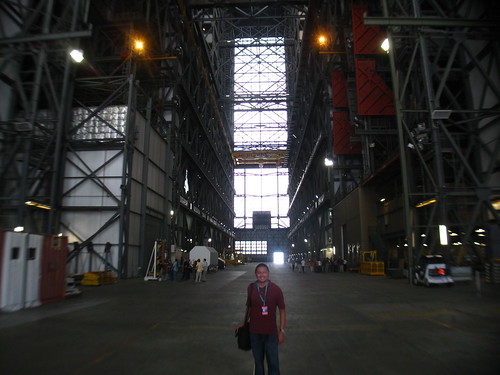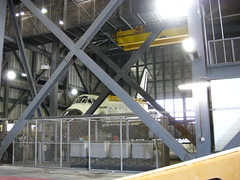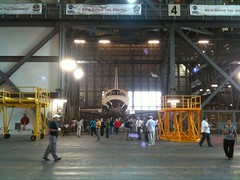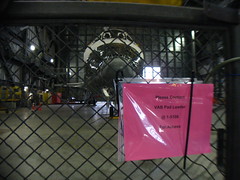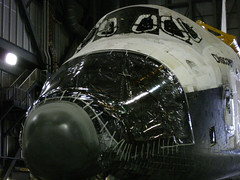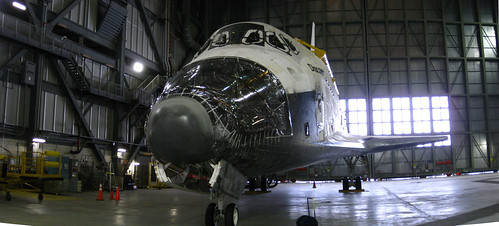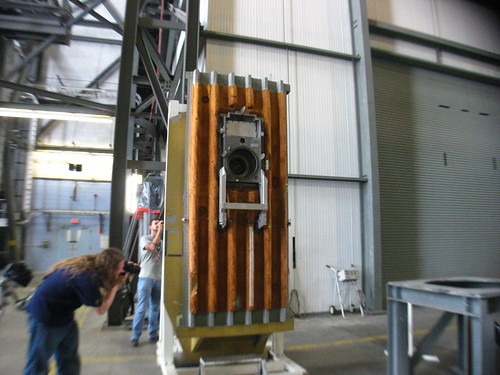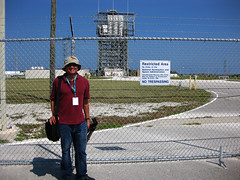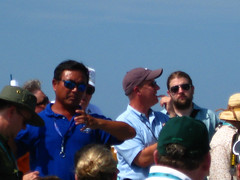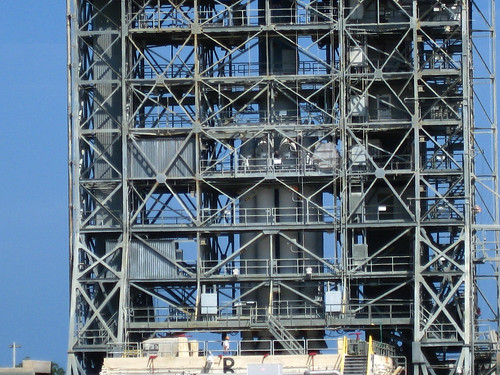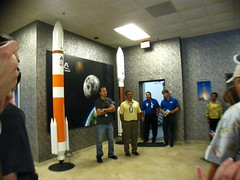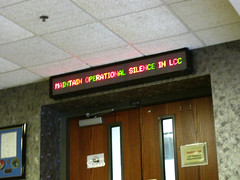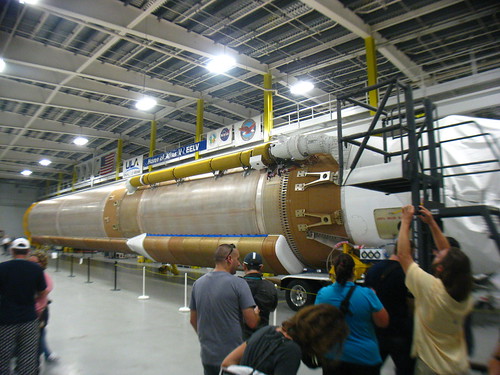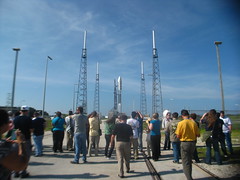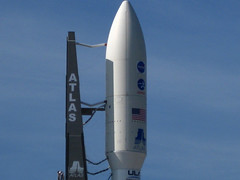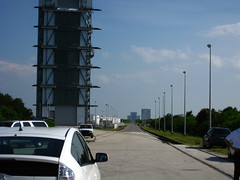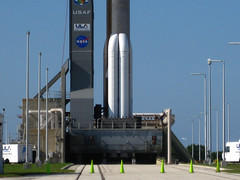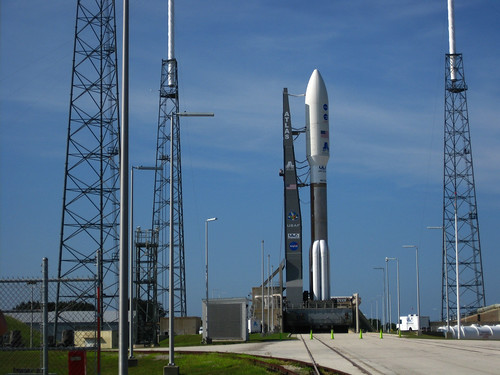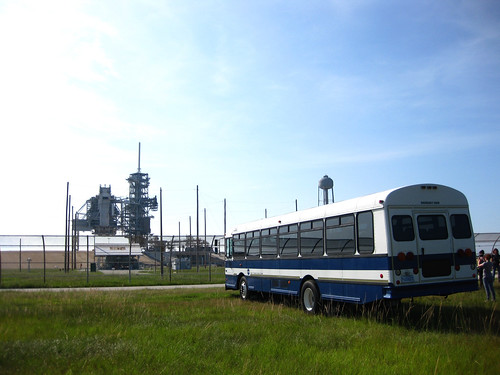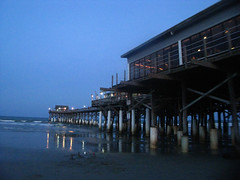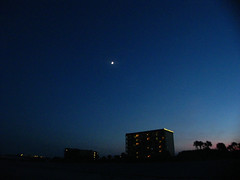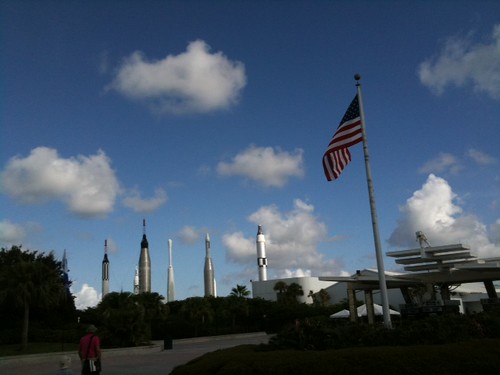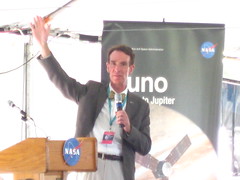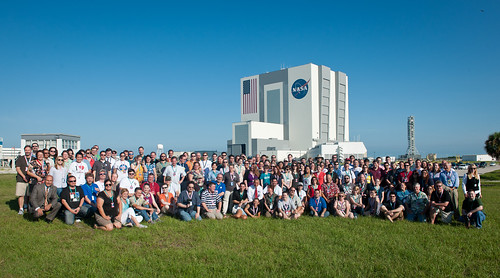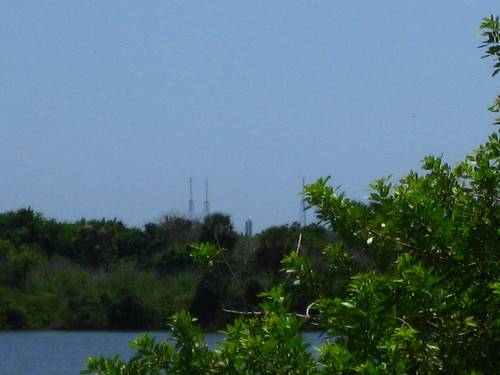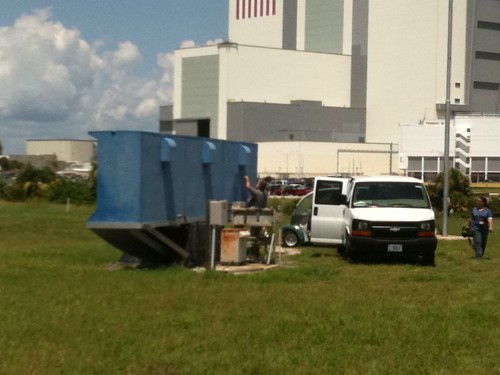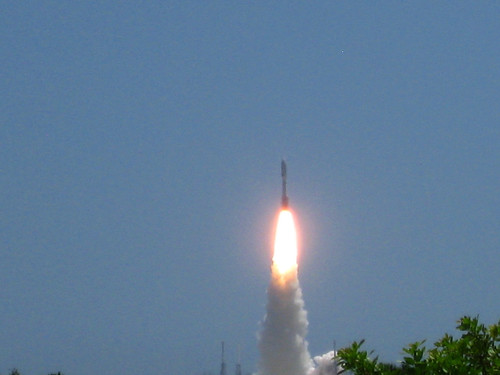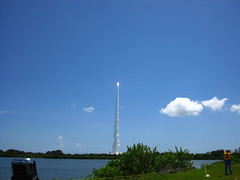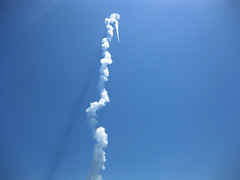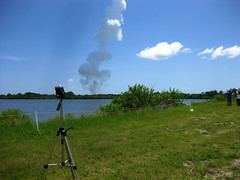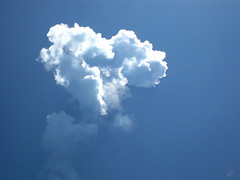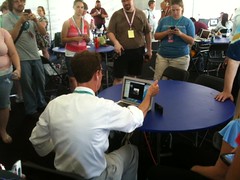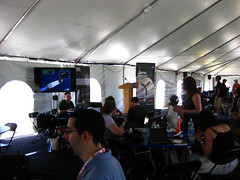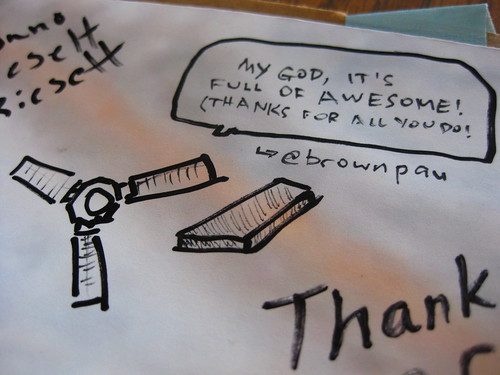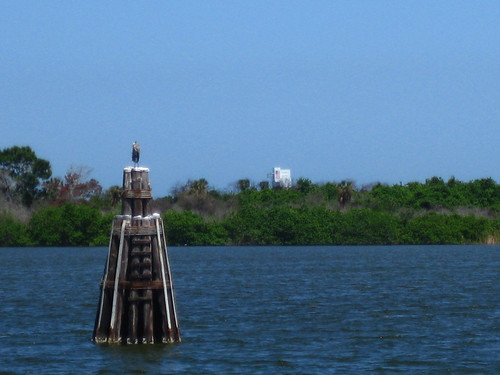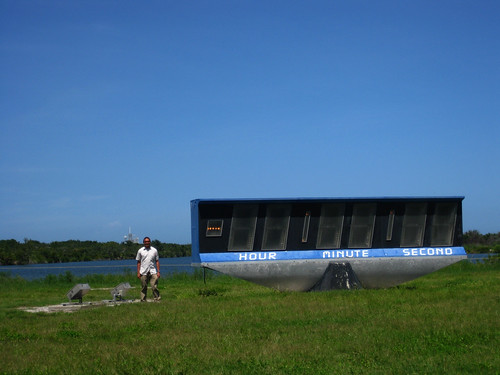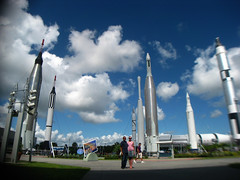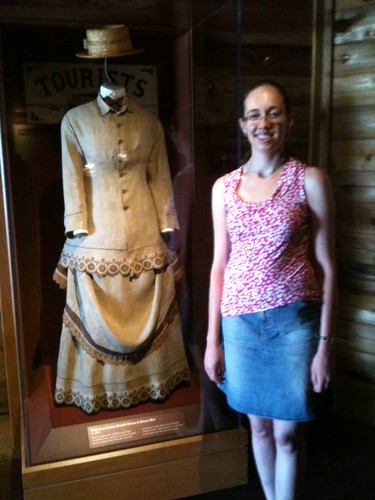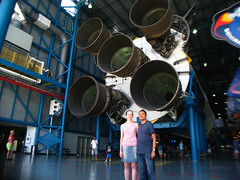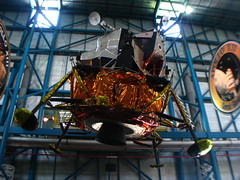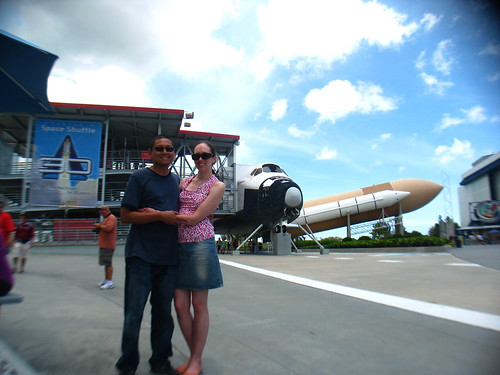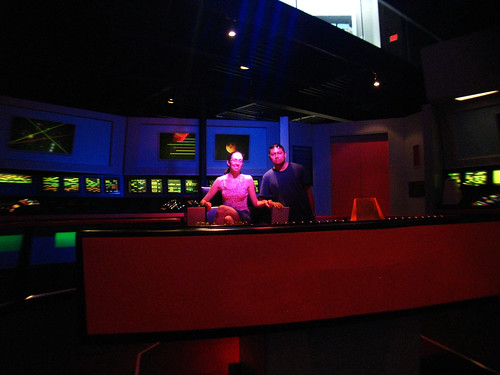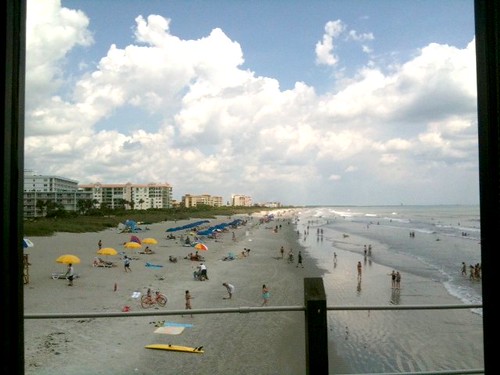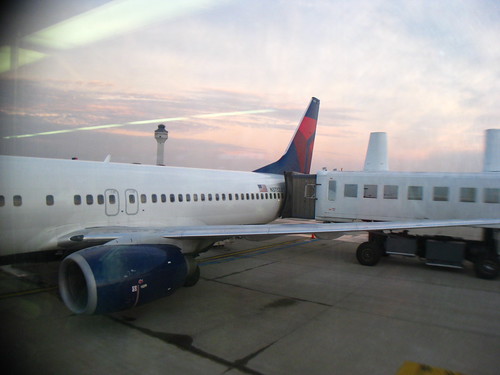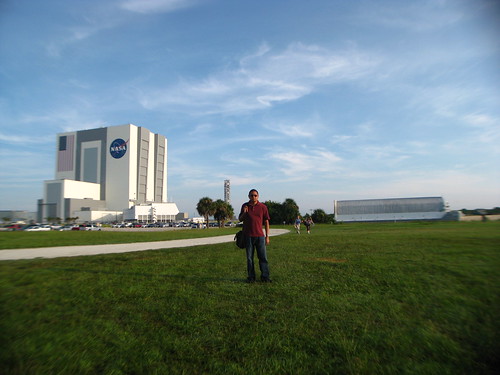In early August 2011 I attended a NASA Tweetup at Kennedy Space Center in Florida, for the launch of Juno, JPL’s new probe to Jupiter.
- Full NASA Tweetup photoset on Flickr
- Video of Space Shuttle Discovery in VAB
- Video of Atlas V Juno launch (sound by Tommy Wingo)
First, a primer: “Tweetup” is a portmanteau for “Twitter Meetup.” NASA selects Twitter users from a signup pool to attend a free conference — talks on science and engineering, tours of various space facilities, and [hopefully] a climactic spacecraft launch — with the implicit agreement that in exchange, attendees come away with a positive message about NASA’s work. It’s a good deal: tweetup audiences tend to be well-informed geeks, usually supportive of NASA, space exploration, and scientific advancement. I and many others were quite glad to leverage the experience and any tweetup-derived online prestige into an excited flurry of tweets, photos, weblog posts, and other online shares. NASA provides the tweetup venue, the tours, and the rocket, but travel and lodging are up to the participant — expenses I was willing to shoulder for the event.
Another important note: NASA is still launching spacecraft. The Space Shuttle program may be over but they have plans for the future, and the launch manifest will not sit idle between Shuttle retirement and whatever comes next.
And so I was quite happy and grateful to be one of 150 people picked to join the NASA Juno Tweetup. Juno would launch on August 5th aboard a ULA Atlas V rocket from Space Launch Complex 41 — NASA’s first post-Shuttle rocket launch from Kennedy Space Center. Naturally since we would be in Florida, I padded out the trip with some beach days and booked a hotel right near Cocoa Beach Pier for additional fun times.
Day 0: Getting There
To get to Florida, we rode Delta Airlines to Melbourne Airport with a layover in Atlanta. I reasoned that the Atlanta layover would be worth Melbourne’s closer proximity to Cape Canaveral (25 miles, as opposed to the 50 miles from Orlando) — but Atlanta Airport was beyond awful. A good portion of the layover involved CNN blaring Ron Paul and cellphone radiation conspiracy woowoos from inescapable TV sets all over the concourse — constant reminders of why I never watch TV news. On the up side there was a Chick-Fil-A in the terminal, which I combined with fried rice and veggies from an Asian takeout counter to make into a yummy Chick-Fil-A rice bowl. On the down side, the food court surprised us with a free airport pickle. I think I will skip any further Atlanta Airport layovers on future trips.
Melbourne Airport, on the other hand, was a nice, small, quiet terminal, easy to navigate, arrivals area rich with reminders of the region’s focus on spaceflight. Our rental car, a 2012 Ford Focus with about 10,000 miles on it, reeked of cigarette smoke, but the odor was easily dispelled by a few minutes’ drive with open windows. The Brevard County/Space Coast area was a joy to drive compared to DC and North Virginia: wide lanes, straight roads, and friendly drivers all around. (I did get a bit lost with a wrong turn right out of the airport, but Amy found our bearings after a quick GPS consultation in an empty parking lot.)
It was about a half-hour drive to the Days Inn Cocoa Beach, where staff were pleasant and the room was cool, and the beach, Pier and a Publix were just a block from the hotel. We had a delicious dinner of arroz con pollo and plantains at Rubio’s, then checked out Ron Jon for a bit before turning in for the night. Big day coming.
Day 1: Talks and Tours
I had to be up with the sun to get to the NASA media accreditation building just outside Kennedy Space Center to register for my tweetup pass and swag bag, starting at 6AM. Other attendees were already there, congregating in the parking lot as they waited for the KSC checkpoint to open.
After 7AM it was another 15 minute drive up Kennedy Parkway to the Tweetup venue, hands-down the most amazing drive I have ever made, through a foggy dawn landscape of subtropical foliage, the famous Vehicle Assembly Building looming ever larger on the horizon with a small lenticular cloud of morning condensation forming a misty dome over its square profile. (I didn’t think to stop for a photo, but elenvee did get a morning VAB picture showing the VAB cloud.) After parking, I got a few shots of myself with the VAB before heading in to the Tweetup Tent.
The Tweetup tent was set up on one side of the historic LC-39 Press Site, within view of the VAB and Countdown Clock. Within the tent, NASA Tweetup staff had generously provided large tables, power strips, fast wifi, and strong air conditioning. As the venue filled up, I claimed a corner spot at an empty table directly beside an air conditioner and a window, which I christened the Cool Corner. Later in the day the tent would heat up uncomfortably, even with multiple portable AC units going full-blast — but the Cool Corner would stay delightfully frigid, with condensation frosting my window view of the VAB. Later neighbors at the table included holmes540, maustan, and flanga.
We started out with a lengthy round of personal introductions, each participant standing to give name, Twitter handle, place of origin, and a random interesting personal fact — a fascinating cross-section of humanity. The official Tweetup event itself then got underway, with NASA TV broadcasting live on cable and UStream.
- Brent Haeseker was able to record everyone’s personal introductions and post them to Vimeo: Part 1, Part 2 (I’m at 19m 30s of Part 2)
- Full Juno Tweetup event from NASA TV (over 2 hours long)
The morning consisted mostly of talks by various NASA/JPL, and ULA speakers on planetary science, robotic exploration, and rocket engineering. Amazing stuff from some smart people, and Dr Tobias Owen, veteran astronomer and discoverer of the rings of Jupiter, sat right at our table (with his wife) to prepare for a science panel. (I spoke to his wife a bit after giving her the wifi access info, but Dr Owen seemed a bit occupied, so I wasn’t able to talk much with him.)
And so that day I learned things like: Juno hardware runs on PPC; it’s the first outer solar system probe to use solar panels rather than RTGs; at Jupiter’s distance the spacecraft’s massive solar panels generate 400W of power (200W of which goes to heating, and the R&D involved will later benefit the solar power industry); Jupiter has the most intense radiation belts in the solar system outside of the sun; the spacecraft’s radiation-proof vault is made of titanium, and individual components are wrapped in germanium-coated sheets for further protection; rice paddies produce methane; we don’t yet know if Jupiter has a solid core; and the spacecraft will be deorbited to prevent loss of control from radiation killing the electronics causing it to crash into a moon and possibly contaminating it. That last bit was quite animatedly demonstrated by Dr Fran Bagenal simulating orbits around a Jupiter globe held by Jason Major while mission designer Steve Matousek expounded:
For lunch we got a two hour break, with NASATweetup staff guiding groups to the KSC LC-39 Cafeteria on the other side of the VAB. (A walk that gave me a good chance to create a VAB wiggle GIF.) The cafeteria was a fairly normal one (I might have been expecting rockets and astronauts all over the place), though the corner TV set to FOX News gave the scene a somewhat sinister bent when I noticed it. I ordered cheap meal of fried chicken with peas, and joined a table with me etcpolitics and Jane and Morris “Mojo” Jones of JPL — veterans of the first ever NASA Tweetup in Pasadena. Very interesting people.
After lunch, the Tweetup group was divided between four tour buses for trips around Kennedy Space Center and Cape Canaveral Air Force Station. I boarded Bus 3 (which would later become infamous for its nonfunctional air conditioning). First stop: the famous Vehicle Assembly Building, inside which bicycles are not allowed. The mind-boggling hugeness of the VAB is well-known, but more striking to me was the sense of sad nostalgia that now filled the space within, a vastness that once buzzed with Apollo stages and Shuttle/ET/SRB stacks. Today a scattering of KSC workers were present, some ready to be laid off with the next pay period, while the VAB hardware lay empty and unused. Out an open bay door at the far end of the building stood the Ares mobile launch gantry, built for a canceled program, now without purpose.
And in a corner bay sat the Space Shuttle Discovery, now retired and in storage, waiting to be prepped for transport to its final home, the Udvar-Hazy Center. This was a pleasant surprise for us in the tour, since the guide had not known any shuttles were still in VAB storage. Discovery sat behind a chain-link fence, barred from close contact due to the risk of residual offgassing and the fragility of the tiled underside. Various parts were missing from the shuttle’s frame, most noticeably the Forward Control Thrusters in the nose cone; the gap in the shuttle’s profile was filled in by a layer of plastic wrap.
- Bus 3 group shot with Space Shuttle Discovery in VAB by Peter Apokotos
- HDR shot of Shuttle by Tim Fritz
In another corner of the VAB, the infamous GUCP (Ground Umbilical Carrier Plate) that had scrubbed an STS-133 launch opportunity sat guiltily excised from its External Tank.
After the VAB, we entered Cape Canaveral Air Force Station (CCAFS), next stop: Space Launch Complex 17, with the ULA Delta II rocket that would carry JPL’s GRAIL mission to the moon. From atop a flatbed trailer turned into makeshift viewing platform, we stared over a security fence at the launch tower and the Delta II still mostly obscured by its service structure, while ULA reps talked about rocket engineering and fielded questions.
Next visit was Atlas Spaceflight Operations Center (ASOC), where we were shown the Atlas LCC (Launch Control Center, no photos allowed) and the cavernous processing facility, where an Atlas V first stage booster and Centaur second stage were being prepared to launch JPL’s next Mars rover, MSL. Photos were allowed of the huge first stage booster, but we were strictly cautioned against photographing the Centaur, which lay in a far corner behind the first stage, still wrapped in plastic.
While in the ASOC LCC, the sense of anticipation for the next day’s launch was heightened by various views of the Atlas V rocket on it’s launch platform shown on multiple monitors, but these were just an appetizer for the next stop: Space Launch Complex 41, where the Atlas V itself stood, Juno probe already loaded into the payload fairing atop the rocket. We were able to approach as close as the launch complex fence, able to see the assembly from just outside the perimeter formed by the four lightning arrestor masts. Behind us was the VIF (Vertical Integration Facility), connected to the launch pad itself by rail tracks for the mobile launch platform. It was an amazing thing to consider that within 18 hours, the spacecraft before us would launch, and where we stood would be a hellstorm of fire and smoke and noise. (A four mile exclusion zone would be enforced around LC-41 before launch.)
On the way back, the bus made a quick stop in a field just outside the fence of LC39A, the only remaining Space Shuttle launch pad, now unused. (LC39B was used for Ares I-X but that was cancelled.) For me the visit was tinged with the same sadness I felt on seeing Discovery in the VAB; here was the launch tower that just recently had seen off STS-135 Atlantis, the last shuttle, now unsure of what would launch next. The bus didn’t stay long; this was an unscheduled stop on the tour, an extra indulgence the tour guide had decided to grant to the Bus 3 group.
The tour ended back at the LC-39 Press Site, and Tweetup Day 1 was over. On the 25 mile drive back to Cocoa Beach I noted how LC-17, the southernmost launch facility in CCAFS, was clearly visible from the Causeway and Port Canaveral area. The Delta II GRAIL launch would be even more prominent to the public than the Atlas V with Juno.
Amy had been enjoying a solo beach day around Cocoa Beach Pier while I was at the Tweetup (one reason I had picked a hotel close to the Pier). We dined on scampi and steak at Boston Beef and Seafood House, then wandered around the beach for a bit at sunset before turning in for the night.
Day 2: Launch
Early morning at 7AM, I dropped off Amy at the KSC Visitor Complex with the free comp director’s pass that had come in the Tweetup swag bag. With that she got a special ticket to watch the launch from the Apollo/Saturn V Center, just a mile from my location at the LC-39 Press Site.
Launch was scheduled for around noon, and the morning Tweetup agenda involved more talks: Andy Aldrin (son of Buzz and now a director for ULA), who prefers the term “human-rating” rather than “man-rating” for rockets; NASA Chief Scientist Waleed Abdalati, who had an inspiring “follow your bliss” type of message about science; and most notably, NASA Administrator Charles Bolden, who likes to use the word “robot” to excite the public more when talking about unmanned exploration. Rex Engelhardt of the NASA Launch Services Program fielded a few questions, Mike Ravine of MSSS talked about JunoCam, Doug Ellisson of JPL presented NASA’s 3D space viewing app Eyes on the Solar System, and artist Dan Goods presented a monolith-like magnetic art installation demonstrating how planetary exploration probes measure variations in gravity. Capping off the morning was Bill Nye (some kind of guy, possibly one of science). At some point, everyone went outside for a group shot with Chuck Bolden backdropped by the VAB.
Atlas launch window opened at 11:34 AM, at which point I set up my camera and tripod out on the field, about midway between the viewing bleachers and the countdown clock. Since the Press Site had originally been made to view Apollo and Shuttle launches from LC-39, it didn’t have quite as optimal a view of the Atlas V at LC-41. Six miles away, the rocket was barely visible through trees and foliage, and from the best spot I could find I got only a view of the payload fairing sticking out between the lighting arrestors. Not that it mattered; we’d seen the whole rocket the day before. This spot was for viewing ascent.
The press site had speakers broadcasting NASA TV audio so viewers could hear updates while outside. Two issues caused launch delays during the countdown hold: a Centaur helium system anomaly, and a boat entering the hazard zone. The helium anomaly turned out to be a manageable ground support issue, and Coast Guard helicopters escorted the errant boat out of range. I was near the famous Press Site Countdown Clock, but it had been non-operational all morning. While I was setting up, a repair man drove up in a white van and started fixing the clock, just minutes to launch.
At 12:21 PM, countdown resumed from a four minute hold, and at 12:25 PM, the Atlas V launched Juno.
Tommy Wingo, a sound engineer who was standing near me at the time, recorded an excellent audio track of the launch, and combined it into my wide-angle footage of the scene:
The Atlas V 551 configuration, with five solid rocket boosters, meant extreme acceleration, with the rocket leaping off the pad and shooting into the sky instantly, leaving a spectacular trail which cast a visible shadow on the atmospheric haze. Sound took about fifteen seconds to reach us: a rumble, then a roar, mingled with the characteristic crackling sound of shock waves from high speed rocket exhaust, fading as the rocket quickly ascended. (Viewers who had been at previous Shuttle launches said this launch had not been as loud.)
As the launch plume dispersed into iridescent ice crystals in the upper atmosphere, the Tweetup crowd returned to the air-conditioned, WiFi-saturated tent to post their photos and videos. The event wasn’t over: through the course of the afternoon NASA/JPL staff raffled off prizes like Juno posters, aerogel cubes, and spare materials and parts from the Juno spacecraft. Bill Nye stayed around the tent for photos and autographs. Those who had suffered through the heat of Bus 3 got an extra consolation prize: red Juno lanyards which I had seen worn only by staff. I found it unnecessary, but a thoughtful gesture on the Tweetup crew’s part.
The event wrapped up very gradually, some people leaving right after launch, others waiting through the raffle. Everyone left a message on the official event banner, and on a smaller Juno poster that Jason Major had purchased for the group to present to NASA Tweetup staff. I drew a little mini-Juno encountering a Monolith.
On my way out, Matthew Balan and I got interviewed by Dave Allen about the Tweetup and our thoughts on the future of human spaceflight. I rambled a bit about Space Shuttle design flaws (side-mounting a giant space truck lined with fragile tiles onto a foam-shedding cryo tank with solid rocket boosters in close proximity) and the need for a reboot in manned spaceflight tech. Back at the parking lot, as I was getting a few last shots of the VAB and a pelican sitting atop a mooring, I spotted a manatee in the water of the Turning Basin, but it was gone before I could photograph it. Pelican looked nice, though:
I also took one last photo of the Countdown Clock, with me standing beside it to show just how large it actually is.
I picked up Amy at the Visitor Complex, opting not to go in myself since it was pretty late. (We would go again the next day, as the comp director pass from the Tweetup gave us an extra free visit.) Back at Cocoa Beach Pier, we found that Atlantic Ocean Grill had a great beach view and a cheap early-bird dinner menu. I had an excellent bowl of mussels in garlic sauce on linguine.
Later in the evening we met up with Scott (who was staying in a nearby hotel) for drinks at Mai Tiki Bar at the very end of the Pier. ($1 admission.) With surfers on the waves and the sunset to the west we talked about spaceflight and aviation and American and Canadian culture. We also got to try Red Stripe, a Jamaican beer.
Day 3: Visitor Complex
After the facility access and launch view I’d gotten at the Tweetup, the touristy KSC Visitor Complex was of course a bit anticlimactic, but still worth a spin for the history. The Rocket Garden was a fun sight, and Early Space Exploration has always had a special place in my heart. As an added bonus, a small side-gallery on Florida history had a few interesting facts and artifacts on view — and the coolest air conditioning in the whole complex.
We also took the bus tour to the Apollo/Saturn V Center (from where Amy had watched the Atlas launch) to view various Apollo program artifacts, plus the full Saturn V stack on its side. The cafe there, less crowded than at the main visitor complex, was an excellent place to eat lunch underneath a lunar module.
There was also a huge flock of turkey vultures cooling themselves in the shade behind the building, and they were fun to watch:
The bus also dropped us at the LC39 Observation Gantry, an observation tower about a mile from LC39A, but knowing that Shuttles would never launch from there again, it seemed more like a wake. (Plus, I had just seen LC39A up close two days before.) Nice panoramic view of the LC39 landscape, though.
Back at the main visitor complex, we checked out the Explorer, a full-size Space Shuttle mockup, and fiddled around with multimedia touchscreens at Exploration Space, a huge interactive science and engineering education-and-pseudo-recruitment center. I also tried buying a NASA backpack at The Space Store but the quality was pretty bad; the zipper teeth kept separating, so I brought it back for a replacement within minutes — and the replacement had the same problem, so I returned it for a refund.
As an added bonus, the Star Trek Exhibit was visiting, so we saw galleries of TV and movie props (from all series, generations, and alternate timelines), sat in the command chair of a rather inexact replica of the Original Series Enterprise bridge, and rode the Star Trek Shuttle Simulator ride. (Protip: skip the simulator ride. No air conditioning, needlessly convoluted plotline, and cheesy 3D graphics, with voice actors — especially Michael Dorn — are just phoning it in.)
Above one of the Star Trek exhibit spaces near the IMAX theater, there was also a NASA Art Gallery, which had several nice paintings. After this, we skipped the live shows, IMAX theaters, and Astronaut Encounter, and left KSCVC early to get back to Cocoa Beach for some beach time. This was my first time actually getting wet in the Atlantic, but struggling with the waves got tiring after a while. The surfers were fun to watch, though.
For dinner we went cheap and got some takeout at Kimbo, a Chinese place beside the Publix across A1A, and just ate it in our hotel room while watching TV. Yeah, we’re that awesome.
Day 4: Homeward
We checked out of the hotel at 11AM but didn’t leave right away; first we sauntered over to the Pier for the Sunday brunch buffet at Atlantic Ocean Grill, enjoyed just once more with the lovely beach view.
Then it was a half-hour drive back to Melbourne Airport to return the car and check-in for our flight. There was a brief delay due to passing thunderstorms, but nothing bad. The flight went quickly, the Atlanta layover was painless, and we were back at Dulles by sunset. One last point of interest: the plane could not get a gate assigment and had to “remote park” on the tarmac and we disembarked directly onto one of the Dulles Mobile Lounges, 1960s-style.
And so ended the NASA Juno Tweetup trip to Florida. Many thanks to NASA, JPL, KSC, ULA, and the NASA Tweetup staff for a magnificent experience that will forever be a memorable nodal moment in my life.
(Oh yeah, one more thing: I lost my iPad. I left it on the plane and never got it back. That’s another story.)
fin
